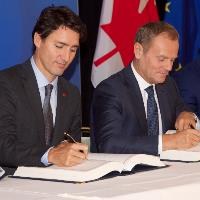(BRUSSELS) – EU leaders and Canadian Prime Minister Justin Trudeau met in Brussels Sunday to sign the Comprehensive Economic and Trade Agreement between the EU and Canada (CETA).
The deal removes 99 per cent of import duties, with a saving to European exporters of industrial goods and agricultural products more than EUR 500 million a year.
ETA is a landmark accord that EU leaders believe sets the benchmark for future agreements, with ambitious chapters on sustainable development, labour and the environment.
“Today, the people of Canada and the European Union have opened a new chapter in their relationship”, said the European Commission’s President Jean-Claude Juncker: “More than half a billion people on both sides of the Atlantic will enjoy new opportunities. For many people, it will mean new jobs and better jobs.”
Trade Commissioner Cecilia Malmstroem said: “When we get rid of unnecessary costs and overlapping bureaucracy, companies will try out new markets and hire more people.”
The leaders also signed the Strategic Partnership Agreement (SPA), which deepens cooperation between the EU and Canada in fields such as foreign policy, crisis management, security and defence, energy and climate, enhanced mobility and people-to-people exchanges.
A joint declaration on the EU-Canada partnership strengthening international cooperation between the two was also adopted.
The Commission lists many advantages for EU firms, with an end to limitations in access to public procurement, so that they bid for public contracts. CETA also opens up the services market, making it easier for professionals such as engineers, accountants and architects to work in Canada.
Canada also recognises the special status of the EU’s Geographical Indications, agreeing to protect a list of more than 140 European goods in Canada, such as Prosciutto di Parma and Schwarzwälder Schinken.
CETA will create new opportunities for farmers and food producers; improves European access to maritime services in Canada and protects unique European agricultural products, so-called Geographical Indications.
The current form of investor-state dispute settlement (ISDS) is replaced with an Investment Court System, but this remains out of the scope of the provisional application of CETA – meaning that it will only be implemented once all Member States conclude their national ratification procedures.
The procedures of the Investment Court will be transparent and its judges appointed by the EU and Canada.The Commission is committed to completing and refining the reform of investment dispute resolution and the discussions of the past few weeks and days have helped shape that commitment.
Some issues, such as healthcare and education, are clarified in a Joint Interpretative Instrument that will have legal force and that clearly and unambiguously outlines what Canada and the European Union have agreed in a number of CETA articles.
After signature, the European Parliament must give its consent to CETA for it to enter into force provisionally. Provisional application, once an agreement has been approved by Member States in the Council and by the European Parliament, allows European businesses and consumers to reap the benefits of the agreement early on.
Further information:
16th EU-Canada Summit Joint Declaration (version français ici)
Text of the Comprehensive Economic and Trade Agreement (CETA)
Annexes to the Comprehensive Economic and Trade Agreement between the EU and Canada


